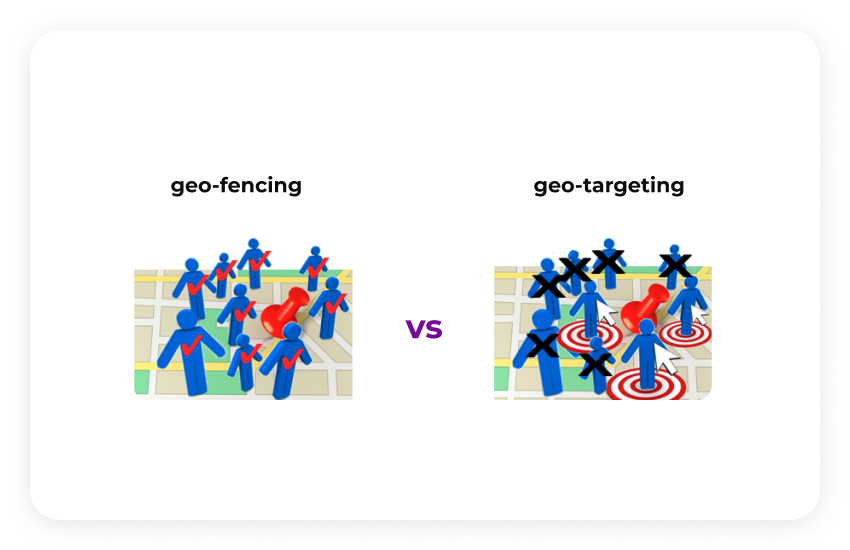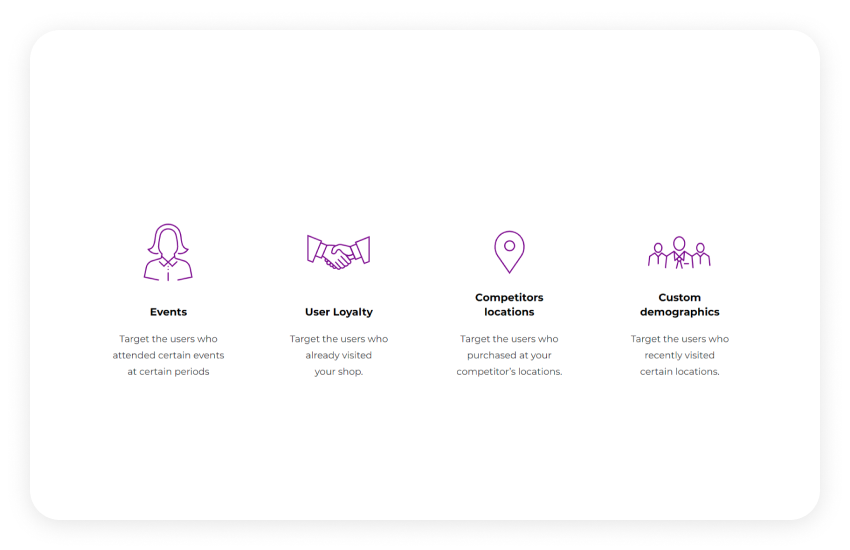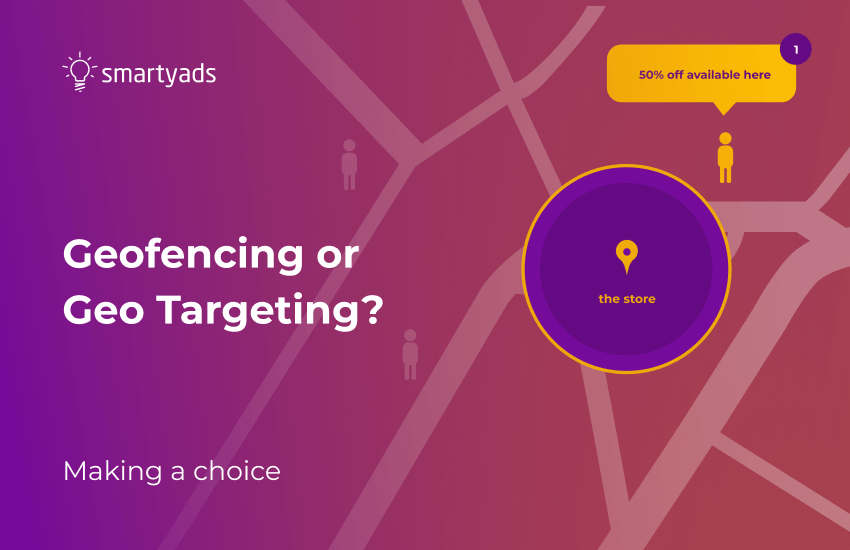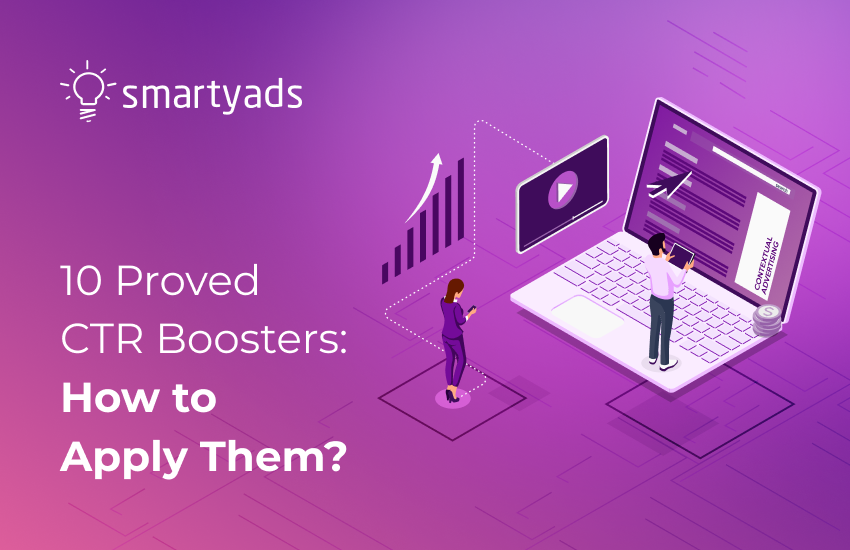Location-based marketing has been giving big promises to the advertising industry ever since users started actively shifting to mobile devices. This approach is based on technologies that utilize current user geolocation and entire travel history to make ‘brand-user’ communication as relevant as possible.
Just step for a moment in the customer’s shoes: you hurry down the street hungry and all of a sudden your phone notifies you about an incredible ‘happy hour’ discount in the cozy local restaurant. Will you go any further? The biggest advantages of the upcoming holiday shopping season this year may also come to the retailers that achieve the best yields using geolocation marketing data as a way to encourage potential customers to visit their store.
Worth to point out, there’s no such competition as “geofencing vs geo targeting.” While these are both tools of location-based data-driven marketing, they use completely different geo segmentation and suit different advertising tactics.
Two mechanisms of location-based marketing
Geotargeting. Defines IP address of user’s PC, (sometimes also GPS) as well as demographic targeting characteristics in order to serve targeted ads. Geo capabilities extend from a particular country to the street or the house number. Example: A coffee brand shows ads to the people that live a few meters away from the shop.
Geofencing. Driven mostly by GPS data it shows ads to people who move within selected geographic areas. Example: A coffee brand shows ads to the people as soon as they move inside of the selected “fence” area where the shop is located. (5 km away, 1 km away, 1 meter away, or else). As you see, there’s no ‘geo targeting vs geofencing. Yes, both tools are efficient at finding audiences in a particular area but there’s more to it.

Core differences
Geotargeting is used in conjunction with data related to the user's preferences and interests. This way brand can create uber personalized and relevant messages with a high CTR. But the key purpose of geotargeting will be selecting users with particular characteristics among all others inside of the selected area.
Geofencing - it is easier to understand it taking into account the main keyword "fence". Using geofencing technology, you build a virtual "fence" and send messages to absolutely all customers who enter or leave the selected area. All this makes geo-targeting a slightly broader notion than geofencing. Although geo targeting and geofencing are pretty much similar, the purposes of the brands that apply them are different.
Geo targeting and geofencing: how and where to use?
When to use geofencing?
Geofencing is recommended for retailers whose products or services are good for broader demographics (beverages, food, etc.) As we already found out, using GPS data, geofencing precisely defines user location: from country to street and house. What marketers can do at this stage is to apply geofencing-specific advertising formats, e.g like push ads and configure performance settings to attract local customers.
Geofencing can also be remarkably effective if you need to get away from the competition. The vivid example is the Dunkin’ Donuts geofencing ad that reassured the users from purchasing coffee from certain locations and provided users with their discount coupons instead.
When to use geotargeting
If geofencing is recommended for retailers whose products or services are good for broader demographics the geotargeting might be also the best bet for more specific niches. For instance, luxury jewellery retailer (demographic women, aged 25-50). Another example - a HVAC company that holds only homeowners as target audiences. Geotargeting option that is available almost at any programmatic media-buying platform, can also suit non-specific product categories just well. What’s even more important, with a variety of targeting options the platform will help to personalize messages in case brand aims to address several audience segments.
Best practices of location-based marketing
Location-based marketing provides unparalleled opportunities for brands and retailers who want to engage people that visit certain places and turn them into customers. It may be an advertising campaign devoted to a specific event, trade fair, concert, conference or just an attempt to find new customers near your competitor’s locations.

When sending promotional offers, it’s nice to remind users about closest stores to them where they can purchase suggested products or services. Another widely-practiced option: send a welcome push ad or another mobile ad format, possibly with a personalized offer, just when the client approaches the store. Apart from these, marketers can successfully apply geofencing and geo targeting for the following purposes.
Find audiences at specific venues they spend time at
Stadiums, airports, universities, shopping centers and other specific locations that your target audience prefers to visit. This way, for instance, hotels target the users that arrive at the airports (and possibly seek for a hotel to stay). Another example of an ad that hits customers when they are most likely to convert: travel insurance offers at the airports (for those who presumably forgot to buy them earlier).
Make location-based landing pages
The landing page is an important thing to keep in mind when you develop geofencing and geo targeting campaigns for different channels. The advertising message should correspond to the information that your landing contains, especially if they contain mention of specific geographical objects. Another innovative option is to create a dynamic landing page that will adapt the message to the target audience. E.g if potential users live in the downtown, they should see the landing page with luxury cars, while those who can’t afford it should be shown standard car models, etc.
Use customer location data to offer added value
The ChargeItSpot, which collaborates with retailers such as Neiman Marcus, Nordstrom, and Bloomingdale, is a picture-perfect example of a perfectly constructed marketing strategy. The service monitors the battery status of mobile phone app users. When the battery is low, the ChargeItSpot sends a notification that contains addresses of the nearest stores where customers can recharge. While the campaign helps customers and solves their ‘low battery anxiety’, it also encourages gadget owners to spend half of their ‘free’ time in retail stores.
Target competitor’s location
Location-based marketing can also work wonders if your task is to replicate the location marketing strategy of your competitors. Target the users near their stores or provide them with discounts when they are staying in the vicinity of your competitor's brick-and-mortar stores. One of the most memorable location-based campaigns of such demonstrated is Meat Pack store. Those users who entered the competitor’s store received a large, vibrant pop-up discount with a reverse countdown: the faster the user managed to get into the store, the bigger discount they got.
Personalize the message
In case you set up a location-based advertising campaign, especially for a network with a large number of retail outlets, keep in mind that people may move from place to place. Thus, they might enter the area you target numerous times per day. To prevent irritation, adtech and martech experts suggest to configure frequency capping and use those digital ad formats that engage and personalize user experience instead of driving irritation. Configuring frequency capping option on DSP, the advertiser will also limit the number of impressions served per each user during the day. As a result, this option will automatically optimize daily campaign spend.
To wrap it up
Location-based advertising is an area of infinite possibilities enabled by geo targeting and geofencing. Based on geodata, you can come up with a creative advertising strategy that is right for your brand. All that you’ll have to do afterward is to find advertising technologies with sufficient targeting functionalities to make those ideas come true. SmartyAds programmatic demand-side platform lets advertisers apply the latest innovations of location-based marketing, cutting-edge advertising formats, and omnichannel approach that will strengthen any campaign performance and elevate ad ROI to the new level.




